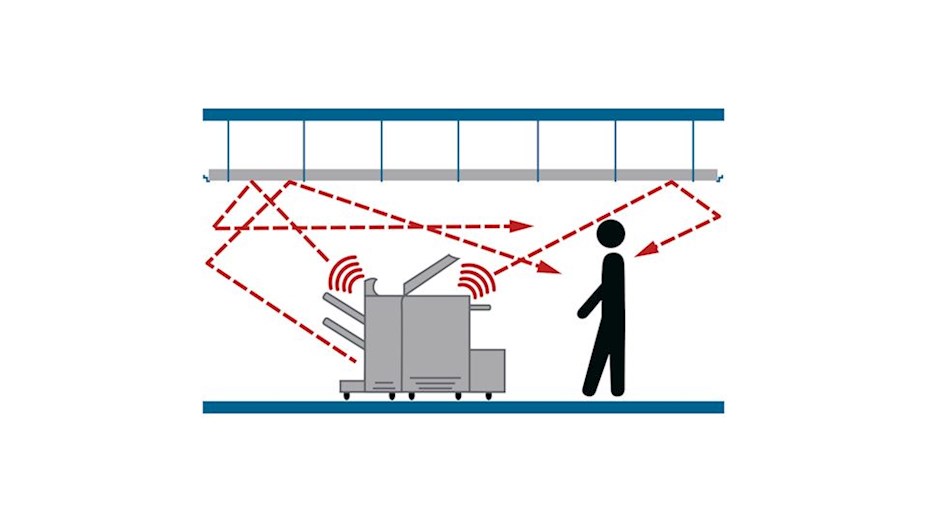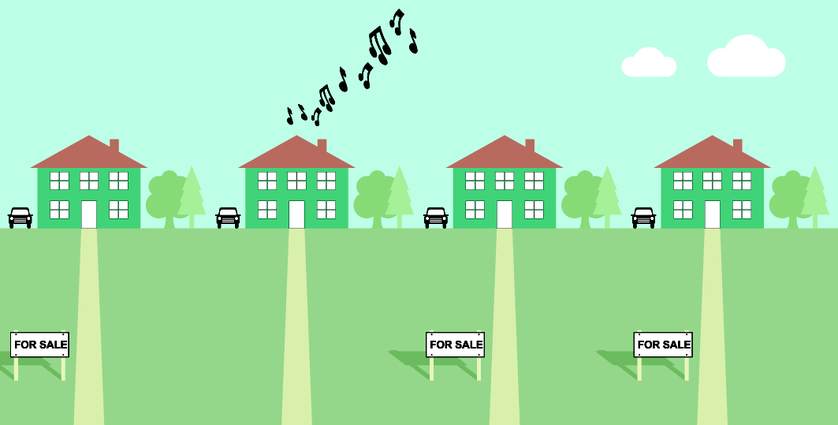How to Soundproof a Bathroom
Let’s face it, the bathroom can be a noisy area at times! Bathroom noises are really not normally ones you want to broadcast throughout the house, yet that’s precisely what occurs always. Soundproofing your bathroom may solve this problem, allowing you to sing at the top of your lungs in the shower, blow-dry your hair, or flush the toilet without disturbing the rest of the household (more info about How to Make a Room Soundproof From Outside Noise on silencewiki.com). Do you want to know how to soundproof a bathroom? Let’s see.

Of course, soundproofing tips might range from really inexpensive to somewhat more costly. In the end, you’ll have to figure out what works best for you. These are a few things you can do to make your bathroom soundproof.
Soundproofing a Bathroom Door
The door is the most significant objective for soundproofing any space. Most interior doors aren’t designed to be soundproof. They have a hollow core and are composed of thin materials. It’s crucial to keep in mind that mass acts as a sound barrier. Because interior doors are composed of thin materials, replacing them with solid-core doors is the simplest approach to enhance bulk and density (read more about soundproofing a bathroom door on bettersoundproofing.com).
However, the additional weight increases material costs and demands a costly replacement. Look for a sturdy slab-style door if you have the money. Alternatively, here are some practical and effective tips for soundproofing your bathroom door!
1. Seal All the Bathroom Door Leaks
To prevent air leaks in your door, follow these steps:
| Step1 | Strip the door trim and use acoustic sealant to seal the frame. |
| Step2 | Use weather stripping on the door’s top and sides. |
| Step3 | Seal the bottom of the door with a draft stopper/sweep. |
| Step4 | Stand on the room side of the bathroom, close the door, and switch off the lights to be sure you’ve sealed all the leaks. |
2. Weatherstripping
Weatherstripping is something we like to talk about a lot on this website, and we mention it in almost every article we produce. It’s for a good reason: it’s extremely cost-effective. Weatherstripping is inexpensive, costing less than $10 a roll. Follow these steps to soundproof your bathroom door using it:
| Step1 | Remove the adhesive backing. |
| Step2 | Open the bathroom door and place the weather stripping within the door frame where the door will close against the frame. |
| Step3 | Make sure the weather stripping wraps completely around the frame. |
Done! That’s easy, right? The fact that it totally seals any gap between your door and the door frame is why it works so effectively. Because weather stripping is meant to keep wind and rain out of external doors, it also works well to keep airborne sound out of the gaps surrounding your door.
3. Install a Soundproofing Blanket
There are various possibilities when it comes to the bathroom door. You might, for instance, buy a soundproof blanket. Soundproof blankets are mostly constructed of materials that absorb sound. They’re normally hung at the back of the door with tacks to keep them in place. If you decide to get a soundproof blanket, keep in mind that they are not that appealing. So, they may interfere with the interior design of your bathroom.
We recommend acquiring a soundproof blanket in a neutral color and making sure it’s installed properly. If you’re looking for a way to lessen echo in a bathroom, the soundproof blanket can also help.
4. Install a Door Sweep
The opening at the bottom of your door is usually where the greatest sound escapes. If you have a wide one-inch space at the bottom of your bathroom door, additional mass and weather stripping around the frame will make little improvement. Wind, dampness, and grime are kept out of doors with the use of door sweeps.
Because of the strong bristles or rubber that make contact with the door as it opens and closes, a tight seal is formed between the sweep and the floor, making sound transmission impossible. A door sweep is simple to install and shouldn’t take more than 15 minutes.
Video: How to Soundproof a Door | DIY Door Soundproofing for under $50
Soundproofing a Bathroom Wall
The bathroom walls are one of the worst enemies when it comes to allowing sound to escape. So, soundproofing the bathroom walls is also essential! Internal walls are usually hollow and uninsulated, allowing sound to easily pass through, therefore soundproofing your bathroom walls will make a significant impact (more info about soundproofing a bathroom wall on soundproofliving.com).
1. Seal up Leaks in Your Bathroom Wall
If there are any apparent holes in your wall, they should be sealed. Even the tiniest crack may allow a great deal of noise to get through. Simply fill the hole with joint compound sealant, making sure to completely cover the crack by applying sealant liberally on both sides of the hole or crack. You may apply another coat once it has dried if required, then sand it down and decorate over it.
2. Install a Drywall
As we keep on mentioning in almost every article, mass blocks sound! So the greatest thing you can do to make your walls sounder resistant is to add additional mass to them.
Installing drywall is another solution for soundproofing your wall. So, to get the most bang for your money, we recommend putting a layer of mass-loaded vinyl between drywall layers and sealing it in with a vibration-dampening sealer like green glue or a green glue alternative.
Installing double drywall for increased efficiency is also an alternative. You might also want to consider putting in a resilient channel. A resilient channel can be used in conjunction with drywall to help reduce impact noise. They are quite strong, but because of their effectiveness, resilient channels are a costly alternative.
Drywalling, on the other hand, will almost certainly need the help of a professional. We recommend finding an expert that can install drywall while preserving the interior design of your bathroom.
3. Position Your Towel Racks Strategically
There are significantly less expensive alternatives to drywall installation if you don’t want to spend a lot of time or money on it. Simply rearranging your bathroom’s furniture may make a huge impact. Placing a towel rack in front of a problem wall and making sure it is maintained full with towels, for instance, can help soften and mask sound before it reaches the wall.
Video: How can I soundproof a bathroom wall?
Soundproofing a Bathroom Floor
When it comes to bathrooms, floors are really not usually a problem. Bathroom floors are often tiled, which means they are thick and well-sealed, preventing airborne sound from passing through. Impact sound, such as vibrations from a person walking, can, nonetheless, be transferred through a bathroom floor (read about soundproofing a floor on soundproofpanda.com).
1. Install a Rug
All you need are some thick fluffy rugs that work well in sound absorption. Obviously, carpeting the bathroom floor isn’t a good idea. So, rubber mats are likely to be your best choice. They are not only inexpensive, but they are also effective. They’re also simple to install and will save you a lot of time. This way, you can soundproof your bathroom floor while also improving its aesthetic appeal.
Sticky mats are available if you have children and are concerned about the mats staying in place. These adhere to the bathroom floor and stay in place. You may also purchase mats with self-adhesive backing.
Soundproofing a Bathroom Toilet
If you have a large family, the toilet will be used frequently. The frequent flushing and the noise of the toilet seat repeatedly striking the tank might be irritating…especially if you’re attempting to sleep in the room next door! Here are some suggestions on making your toilet flush quietly (16 Tips To Soundproof Your Toilet on easyhomesoundproofing.com).
1. Add Padding
Get a toilet lid cover if you don’t have one already. This will aid to muffle the pressure on the tank. In addition, adding some extra padding to the tank itself is a terrific idea!
Bumpers that reduce noise would be excellent. Place the bumpers on your toilet tank in the precise spot where the toilet lid would come into contact with it. You may also put some bumpers on the underside of the toilet seat to reduce the noise it produces when it is dropped.
This should fully eliminate the startling sound of porcelain against porcelain and give your household a bit more quietness.
2. Soundproof the Toilet Tank
Soundproofing a tank is an excellent option if your toilet has a very loud flush or if you can frequently hear water running within the tank. You’ll need some sticky foam tape for this. Follow these methods to soundproof your toilet tank:
| Step1 | Remove the cover from your toilet tank and wash the top and interior edges. |
| Step2 | Remove the adhesive foam’s backside and put it over the top corners of your toilet tank, folding it within the toilet’s wall as well. |
| Step3 | Push the tank cover back into place securely – you should notice a tighter and more sound-proof fit. |
3. Soundproof the Toilet Seat
If you want to entirely eliminate bathroom noise, you can’t neglect the toilet seat. One of the most unpleasant sounds coming from the bathroom is when the seat starts falling down. Hearing the noise again and over might get on your nerves if you have guests around! Sure, the simplest solution is for everyone to be more careful while putting down the toilet seat.
However, in most situations, this will only last a few days before you fall back into your previous habits. Is there any suggestion on how to make the toilet quieter? Self-adhesive silicone pads are the solution you’re looking for!
You’ll need one on the toilet set where the lid comes into contact with the tank when it’s elevated. On the underside of the toilet seat cover, a second pad should be attached. And, between the toilet and the seat, make sure you have a few more pads.
Video: Cool DIY Bathroom Hack – Soundproofing Your Toilet Seat – Drain Help
Soundproofing a Bathroom Pipes
The rattling sound of bathroom pipes is well-known. Clamping the mounting straps or clamps that keep the pipes in place is a great place to begin if you hear creaking pipes in your bathroom. The pipes themselves should be soundproofed as well. Because you have complete access to the pipes, soundproofing during construction is perfect, just like the rest of the bathroom.
However, there are two main ways to soundproof pipes: filling the pipe cavities or wrapping them in sound absorption materials. Wrapping the pipes is often the simplest option. When selecting materials, make sure they can wrap around your pipes, like PVC, cast iron, or copper. To assist deaden impact noise, the coverings are commonly composed of materials like polyurethane foam.
Video: Quiet Plumbing Pipes
In Сonclusion
A soundproof bathroom is necessary to keep your own business! Except for the person who is in the bathroom, no one- I mean no one needs to know what is going on there.
It is not necessary to spend a lot of money to soundproof the bathroom. Even the tiniest thing, such as gap sealing, can make a huge difference. If the noise from your bathroom is bothering you, try some of the suggestions we mentioned above and see what a difference they make.



